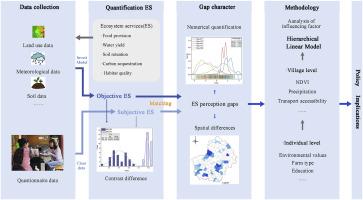生态系统服务与居民感知之间的差异是什么?从认知差距、异质性和跨层次驱动机制的见解
IF 5.4
2区 地球科学
Q1 GEOGRAPHY
引用次数: 0
摘要
生态系统服务对人类福祉和生态安全至关重要。然而,目前的研究往往将客观测量与主观感知评价分开,很少同时考虑这两个方面,也很少深入分析两者的匹配关系。本研究超越了客观或主观主导的传统范式,提出了一个空间外显的认知生态反馈概念框架。我们开发了一种综合方法,将InVEST模型输出与问卷调查数据结合起来,将客观ES供应与主观感知联系起来,将其差异定义为感知差距。以环江县典型喀斯特地区为例,量化了粮食供给(FP)、水量(WY)、土壤保持(SR)、碳固存(CS)和生境质量(HQ) 5个关键生态系统的潜在供给和农户感知缺口。然后,我们使用层次线性模型来确定跨层驱动机制。研究结果显示,5个社会服务体系之间存在显著的服务异质性和个体差异。计划生育和WY的认知差距总体上是积极的,反映了高需求和低供应。此外,CS及总部服务的评分则以负为主,显示需求低而供应高。感知差距的形成机制在个体层面受环境价值观和家庭类型的共同驱动,在村庄层面受自然条件和区位因素的共同驱动。该研究强调,差异化的治理策略对于弥合多种类型的认知差距至关重要,从而通过提高意识、优化服务提供和改善政策沟通,促进认知和生态可持续性的良性循环。本文章由计算机程序翻译,如有差异,请以英文原文为准。

What are the differences between ecosystem services and residents’ perceptions? Insights from perception gap, heterogeneity, and cross-level driving mechanisms
Ecosystem services (ES) are vital for human well-being and ecological security. However, current research often separates objective measurement from subjective perception evaluation, rarely considering both aspects simultaneously or analyzing their matching relationship in depth. This study moves beyond the traditional paradigm of objective or subjective dominance and proposes a spatially explicit cognition–ecology feedback conceptual framework. We developed an integrated approach that couples InVEST model outputs with questionnaire survey data to link objective ES supply with subjective perceptions, defining their difference as perception gaps. Taking the typical karst area of Huanjiang County, China, as a case study, we quantified the potential supply and farmers’ perception gaps of five key ES, namely, food provision (FP), water yield (WY), soil retention (SR), carbon sequestration (CS), and habitat quality (HQ). We then used a Hierarchical Linear Model to determine the cross-level driving mechanisms. The findings showed significant service heterogeneity and individual differences among the five ES. Perception gaps for FP and WY were generally positive, reflecting high demand and low supply. Meanwhile, those for CS and HQ services were predominantly negative, indicating low demand and high supply. The formation mechanism of perception gap was jointly driven by environmental values and household types at the individual level, and natural conditions and location factors at the village level. The study emphasizes that differentiated governance strategies are essential to bridge multiple types of perception gaps, thereby fostering a virtuous cycle of cognition and ecological sustainability through enhanced awareness, optimized service provision, and improved policy communication.
求助全文
通过发布文献求助,成功后即可免费获取论文全文。
去求助
来源期刊

Applied Geography
GEOGRAPHY-
CiteScore
8.00
自引率
2.00%
发文量
134
期刊介绍:
Applied Geography is a journal devoted to the publication of research which utilizes geographic approaches (human, physical, nature-society and GIScience) to resolve human problems that have a spatial dimension. These problems may be related to the assessment, management and allocation of the world physical and/or human resources. The underlying rationale of the journal is that only through a clear understanding of the relevant societal, physical, and coupled natural-humans systems can we resolve such problems. Papers are invited on any theme involving the application of geographical theory and methodology in the resolution of human problems.
 求助内容:
求助内容: 应助结果提醒方式:
应助结果提醒方式:


